Networking Questions and Answers | Assignment
VerifiedAdded on 2022/08/13
|11
|2117
|36
AI Summary
Contribute Materials
Your contribution can guide someone’s learning journey. Share your
documents today.
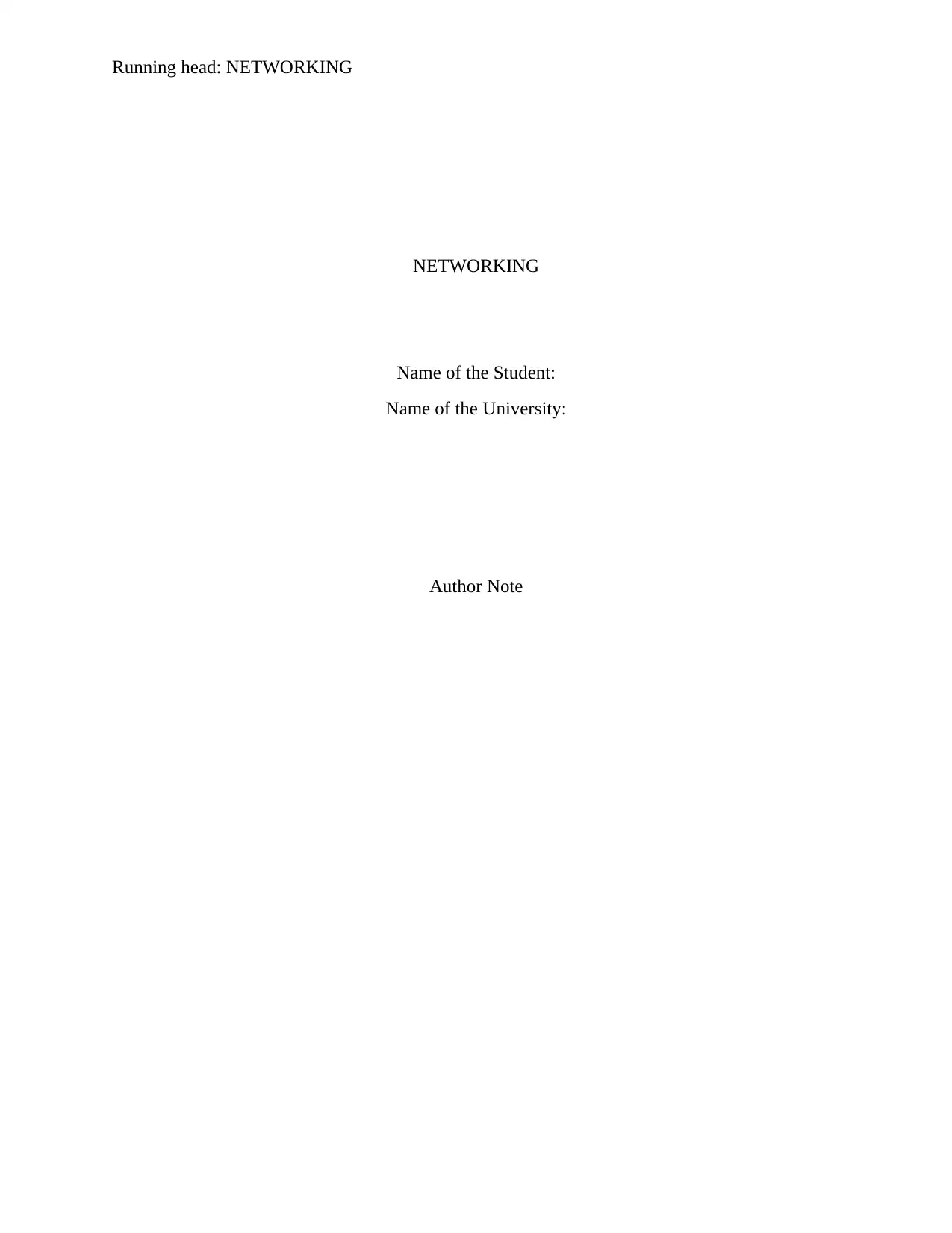
Running head: NETWORKING
NETWORKING
Name of the Student:
Name of the University:
Author Note
NETWORKING
Name of the Student:
Name of the University:
Author Note
Secure Best Marks with AI Grader
Need help grading? Try our AI Grader for instant feedback on your assignments.
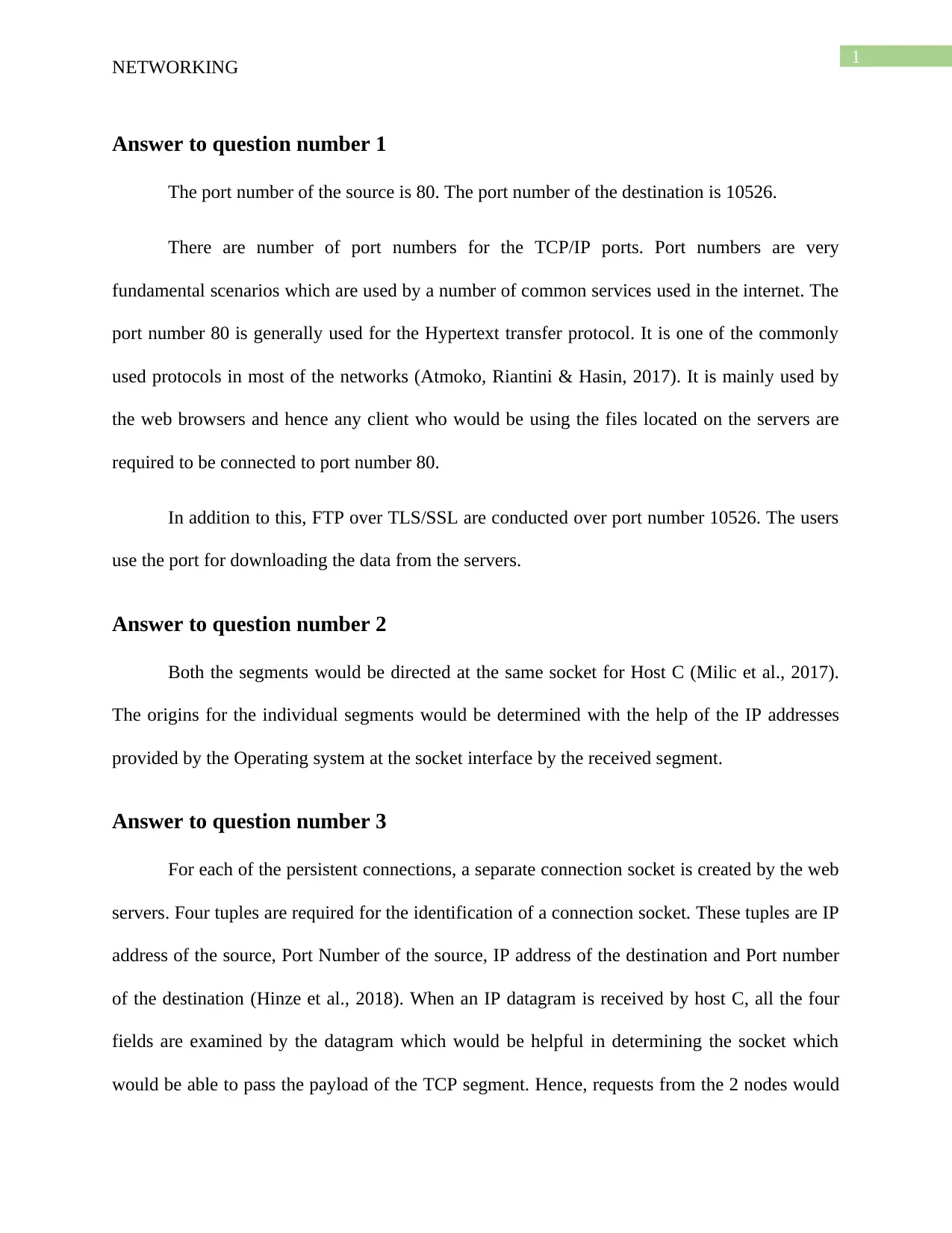
1
NETWORKING
Answer to question number 1
The port number of the source is 80. The port number of the destination is 10526.
There are number of port numbers for the TCP/IP ports. Port numbers are very
fundamental scenarios which are used by a number of common services used in the internet. The
port number 80 is generally used for the Hypertext transfer protocol. It is one of the commonly
used protocols in most of the networks (Atmoko, Riantini & Hasin, 2017). It is mainly used by
the web browsers and hence any client who would be using the files located on the servers are
required to be connected to port number 80.
In addition to this, FTP over TLS/SSL are conducted over port number 10526. The users
use the port for downloading the data from the servers.
Answer to question number 2
Both the segments would be directed at the same socket for Host C (Milic et al., 2017).
The origins for the individual segments would be determined with the help of the IP addresses
provided by the Operating system at the socket interface by the received segment.
Answer to question number 3
For each of the persistent connections, a separate connection socket is created by the web
servers. Four tuples are required for the identification of a connection socket. These tuples are IP
address of the source, Port Number of the source, IP address of the destination and Port number
of the destination (Hinze et al., 2018). When an IP datagram is received by host C, all the four
fields are examined by the datagram which would be helpful in determining the socket which
would be able to pass the payload of the TCP segment. Hence, requests from the 2 nodes would
NETWORKING
Answer to question number 1
The port number of the source is 80. The port number of the destination is 10526.
There are number of port numbers for the TCP/IP ports. Port numbers are very
fundamental scenarios which are used by a number of common services used in the internet. The
port number 80 is generally used for the Hypertext transfer protocol. It is one of the commonly
used protocols in most of the networks (Atmoko, Riantini & Hasin, 2017). It is mainly used by
the web browsers and hence any client who would be using the files located on the servers are
required to be connected to port number 80.
In addition to this, FTP over TLS/SSL are conducted over port number 10526. The users
use the port for downloading the data from the servers.
Answer to question number 2
Both the segments would be directed at the same socket for Host C (Milic et al., 2017).
The origins for the individual segments would be determined with the help of the IP addresses
provided by the Operating system at the socket interface by the received segment.
Answer to question number 3
For each of the persistent connections, a separate connection socket is created by the web
servers. Four tuples are required for the identification of a connection socket. These tuples are IP
address of the source, Port Number of the source, IP address of the destination and Port number
of the destination (Hinze et al., 2018). When an IP datagram is received by host C, all the four
fields are examined by the datagram which would be helpful in determining the socket which
would be able to pass the payload of the TCP segment. Hence, requests from the 2 nodes would
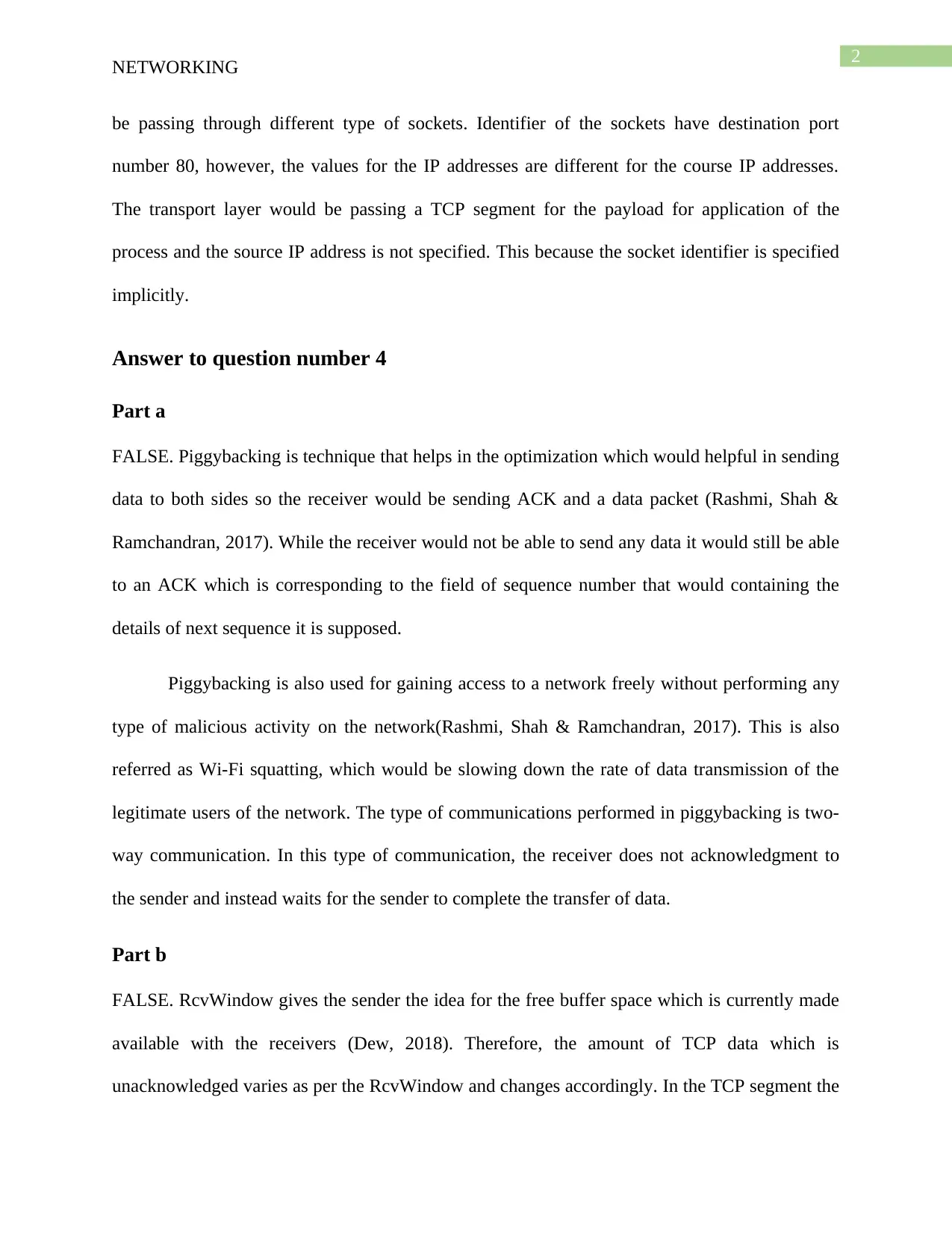
2
NETWORKING
be passing through different type of sockets. Identifier of the sockets have destination port
number 80, however, the values for the IP addresses are different for the course IP addresses.
The transport layer would be passing a TCP segment for the payload for application of the
process and the source IP address is not specified. This because the socket identifier is specified
implicitly.
Answer to question number 4
Part a
FALSE. Piggybacking is technique that helps in the optimization which would helpful in sending
data to both sides so the receiver would be sending ACK and a data packet (Rashmi, Shah &
Ramchandran, 2017). While the receiver would not be able to send any data it would still be able
to an ACK which is corresponding to the field of sequence number that would containing the
details of next sequence it is supposed.
Piggybacking is also used for gaining access to a network freely without performing any
type of malicious activity on the network(Rashmi, Shah & Ramchandran, 2017). This is also
referred as Wi-Fi squatting, which would be slowing down the rate of data transmission of the
legitimate users of the network. The type of communications performed in piggybacking is two-
way communication. In this type of communication, the receiver does not acknowledgment to
the sender and instead waits for the sender to complete the transfer of data.
Part b
FALSE. RcvWindow gives the sender the idea for the free buffer space which is currently made
available with the receivers (Dew, 2018). Therefore, the amount of TCP data which is
unacknowledged varies as per the RcvWindow and changes accordingly. In the TCP segment the
NETWORKING
be passing through different type of sockets. Identifier of the sockets have destination port
number 80, however, the values for the IP addresses are different for the course IP addresses.
The transport layer would be passing a TCP segment for the payload for application of the
process and the source IP address is not specified. This because the socket identifier is specified
implicitly.
Answer to question number 4
Part a
FALSE. Piggybacking is technique that helps in the optimization which would helpful in sending
data to both sides so the receiver would be sending ACK and a data packet (Rashmi, Shah &
Ramchandran, 2017). While the receiver would not be able to send any data it would still be able
to an ACK which is corresponding to the field of sequence number that would containing the
details of next sequence it is supposed.
Piggybacking is also used for gaining access to a network freely without performing any
type of malicious activity on the network(Rashmi, Shah & Ramchandran, 2017). This is also
referred as Wi-Fi squatting, which would be slowing down the rate of data transmission of the
legitimate users of the network. The type of communications performed in piggybacking is two-
way communication. In this type of communication, the receiver does not acknowledgment to
the sender and instead waits for the sender to complete the transfer of data.
Part b
FALSE. RcvWindow gives the sender the idea for the free buffer space which is currently made
available with the receivers (Dew, 2018). Therefore, the amount of TCP data which is
unacknowledged varies as per the RcvWindow and changes accordingly. In the TCP segment the
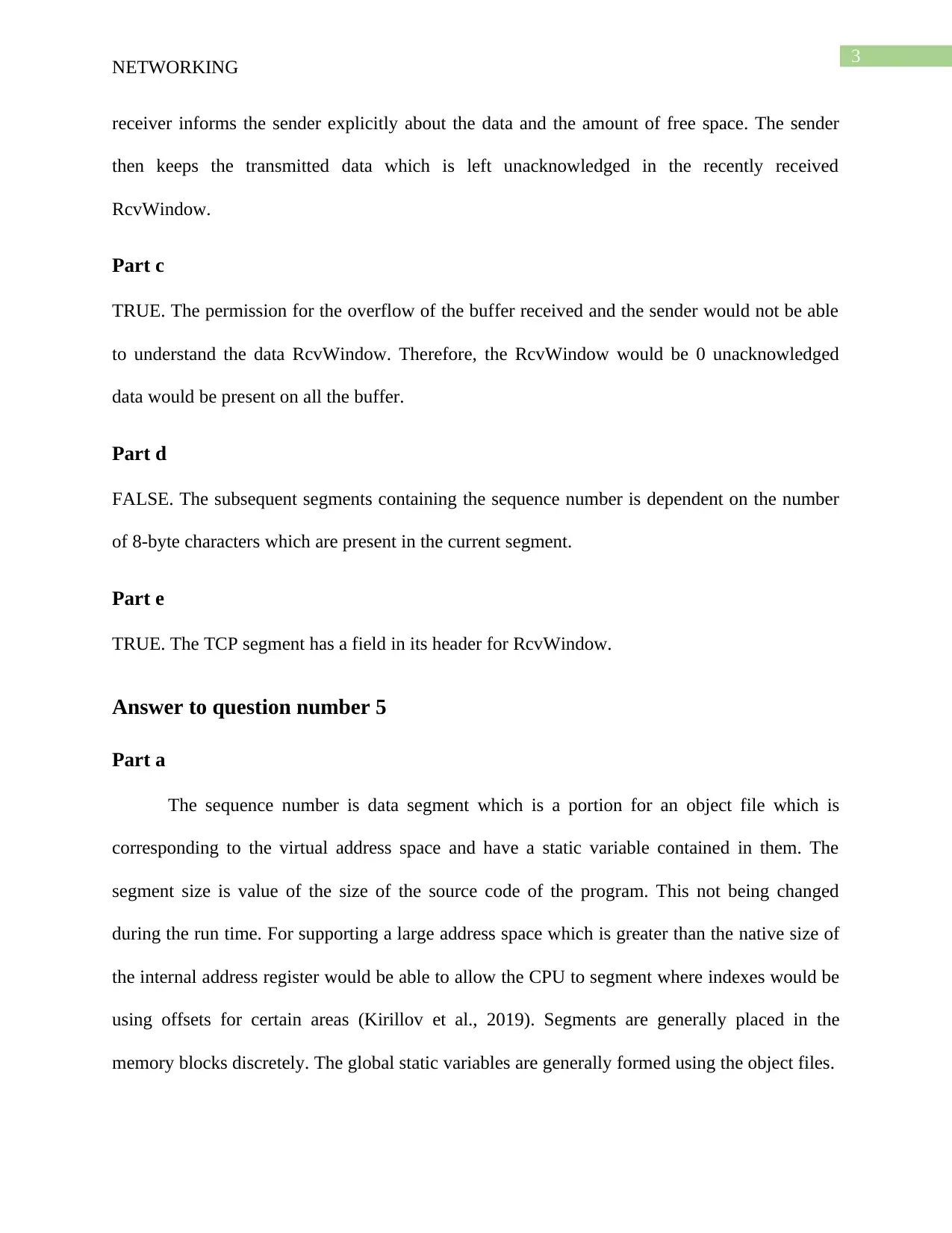
3
NETWORKING
receiver informs the sender explicitly about the data and the amount of free space. The sender
then keeps the transmitted data which is left unacknowledged in the recently received
RcvWindow.
Part c
TRUE. The permission for the overflow of the buffer received and the sender would not be able
to understand the data RcvWindow. Therefore, the RcvWindow would be 0 unacknowledged
data would be present on all the buffer.
Part d
FALSE. The subsequent segments containing the sequence number is dependent on the number
of 8-byte characters which are present in the current segment.
Part e
TRUE. The TCP segment has a field in its header for RcvWindow.
Answer to question number 5
Part a
The sequence number is data segment which is a portion for an object file which is
corresponding to the virtual address space and have a static variable contained in them. The
segment size is value of the size of the source code of the program. This not being changed
during the run time. For supporting a large address space which is greater than the native size of
the internal address register would be able to allow the CPU to segment where indexes would be
using offsets for certain areas (Kirillov et al., 2019). Segments are generally placed in the
memory blocks discretely. The global static variables are generally formed using the object files.
NETWORKING
receiver informs the sender explicitly about the data and the amount of free space. The sender
then keeps the transmitted data which is left unacknowledged in the recently received
RcvWindow.
Part c
TRUE. The permission for the overflow of the buffer received and the sender would not be able
to understand the data RcvWindow. Therefore, the RcvWindow would be 0 unacknowledged
data would be present on all the buffer.
Part d
FALSE. The subsequent segments containing the sequence number is dependent on the number
of 8-byte characters which are present in the current segment.
Part e
TRUE. The TCP segment has a field in its header for RcvWindow.
Answer to question number 5
Part a
The sequence number is data segment which is a portion for an object file which is
corresponding to the virtual address space and have a static variable contained in them. The
segment size is value of the size of the source code of the program. This not being changed
during the run time. For supporting a large address space which is greater than the native size of
the internal address register would be able to allow the CPU to segment where indexes would be
using offsets for certain areas (Kirillov et al., 2019). Segments are generally placed in the
memory blocks discretely. The global static variables are generally formed using the object files.
Secure Best Marks with AI Grader
Need help grading? Try our AI Grader for instant feedback on your assignments.
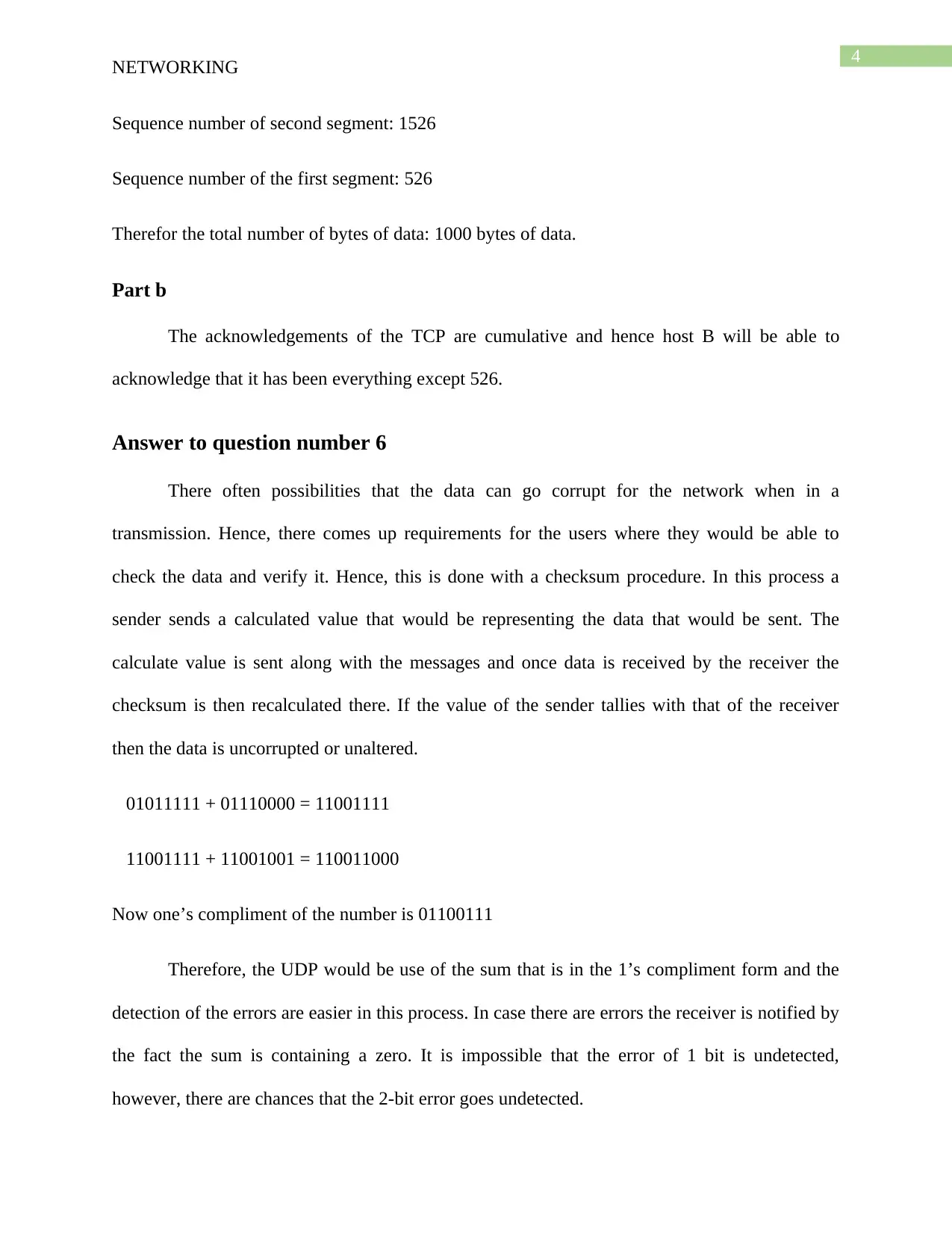
4
NETWORKING
Sequence number of second segment: 1526
Sequence number of the first segment: 526
Therefor the total number of bytes of data: 1000 bytes of data.
Part b
The acknowledgements of the TCP are cumulative and hence host B will be able to
acknowledge that it has been everything except 526.
Answer to question number 6
There often possibilities that the data can go corrupt for the network when in a
transmission. Hence, there comes up requirements for the users where they would be able to
check the data and verify it. Hence, this is done with a checksum procedure. In this process a
sender sends a calculated value that would be representing the data that would be sent. The
calculate value is sent along with the messages and once data is received by the receiver the
checksum is then recalculated there. If the value of the sender tallies with that of the receiver
then the data is uncorrupted or unaltered.
01011111 + 01110000 = 11001111
11001111 + 11001001 = 110011000
Now one’s compliment of the number is 01100111
Therefore, the UDP would be use of the sum that is in the 1’s compliment form and the
detection of the errors are easier in this process. In case there are errors the receiver is notified by
the fact the sum is containing a zero. It is impossible that the error of 1 bit is undetected,
however, there are chances that the 2-bit error goes undetected.
NETWORKING
Sequence number of second segment: 1526
Sequence number of the first segment: 526
Therefor the total number of bytes of data: 1000 bytes of data.
Part b
The acknowledgements of the TCP are cumulative and hence host B will be able to
acknowledge that it has been everything except 526.
Answer to question number 6
There often possibilities that the data can go corrupt for the network when in a
transmission. Hence, there comes up requirements for the users where they would be able to
check the data and verify it. Hence, this is done with a checksum procedure. In this process a
sender sends a calculated value that would be representing the data that would be sent. The
calculate value is sent along with the messages and once data is received by the receiver the
checksum is then recalculated there. If the value of the sender tallies with that of the receiver
then the data is uncorrupted or unaltered.
01011111 + 01110000 = 11001111
11001111 + 11001001 = 110011000
Now one’s compliment of the number is 01100111
Therefore, the UDP would be use of the sum that is in the 1’s compliment form and the
detection of the errors are easier in this process. In case there are errors the receiver is notified by
the fact the sum is containing a zero. It is impossible that the error of 1 bit is undetected,
however, there are chances that the 2-bit error goes undetected.
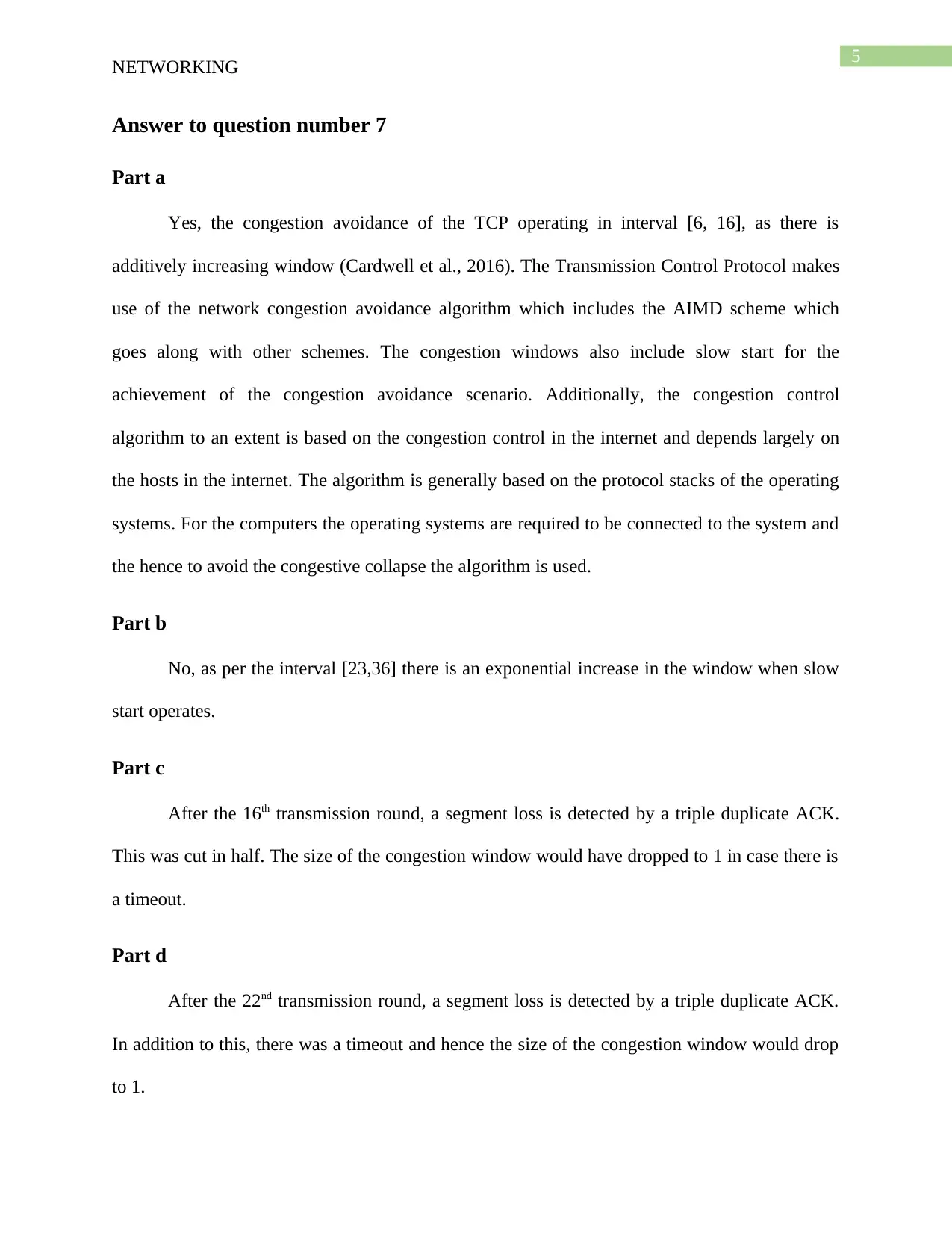
5
NETWORKING
Answer to question number 7
Part a
Yes, the congestion avoidance of the TCP operating in interval [6, 16], as there is
additively increasing window (Cardwell et al., 2016). The Transmission Control Protocol makes
use of the network congestion avoidance algorithm which includes the AIMD scheme which
goes along with other schemes. The congestion windows also include slow start for the
achievement of the congestion avoidance scenario. Additionally, the congestion control
algorithm to an extent is based on the congestion control in the internet and depends largely on
the hosts in the internet. The algorithm is generally based on the protocol stacks of the operating
systems. For the computers the operating systems are required to be connected to the system and
the hence to avoid the congestive collapse the algorithm is used.
Part b
No, as per the interval [23,36] there is an exponential increase in the window when slow
start operates.
Part c
After the 16th transmission round, a segment loss is detected by a triple duplicate ACK.
This was cut in half. The size of the congestion window would have dropped to 1 in case there is
a timeout.
Part d
After the 22nd transmission round, a segment loss is detected by a triple duplicate ACK.
In addition to this, there was a timeout and hence the size of the congestion window would drop
to 1.
NETWORKING
Answer to question number 7
Part a
Yes, the congestion avoidance of the TCP operating in interval [6, 16], as there is
additively increasing window (Cardwell et al., 2016). The Transmission Control Protocol makes
use of the network congestion avoidance algorithm which includes the AIMD scheme which
goes along with other schemes. The congestion windows also include slow start for the
achievement of the congestion avoidance scenario. Additionally, the congestion control
algorithm to an extent is based on the congestion control in the internet and depends largely on
the hosts in the internet. The algorithm is generally based on the protocol stacks of the operating
systems. For the computers the operating systems are required to be connected to the system and
the hence to avoid the congestive collapse the algorithm is used.
Part b
No, as per the interval [23,36] there is an exponential increase in the window when slow
start operates.
Part c
After the 16th transmission round, a segment loss is detected by a triple duplicate ACK.
This was cut in half. The size of the congestion window would have dropped to 1 in case there is
a timeout.
Part d
After the 22nd transmission round, a segment loss is detected by a triple duplicate ACK.
In addition to this, there was a timeout and hence the size of the congestion window would drop
to 1.
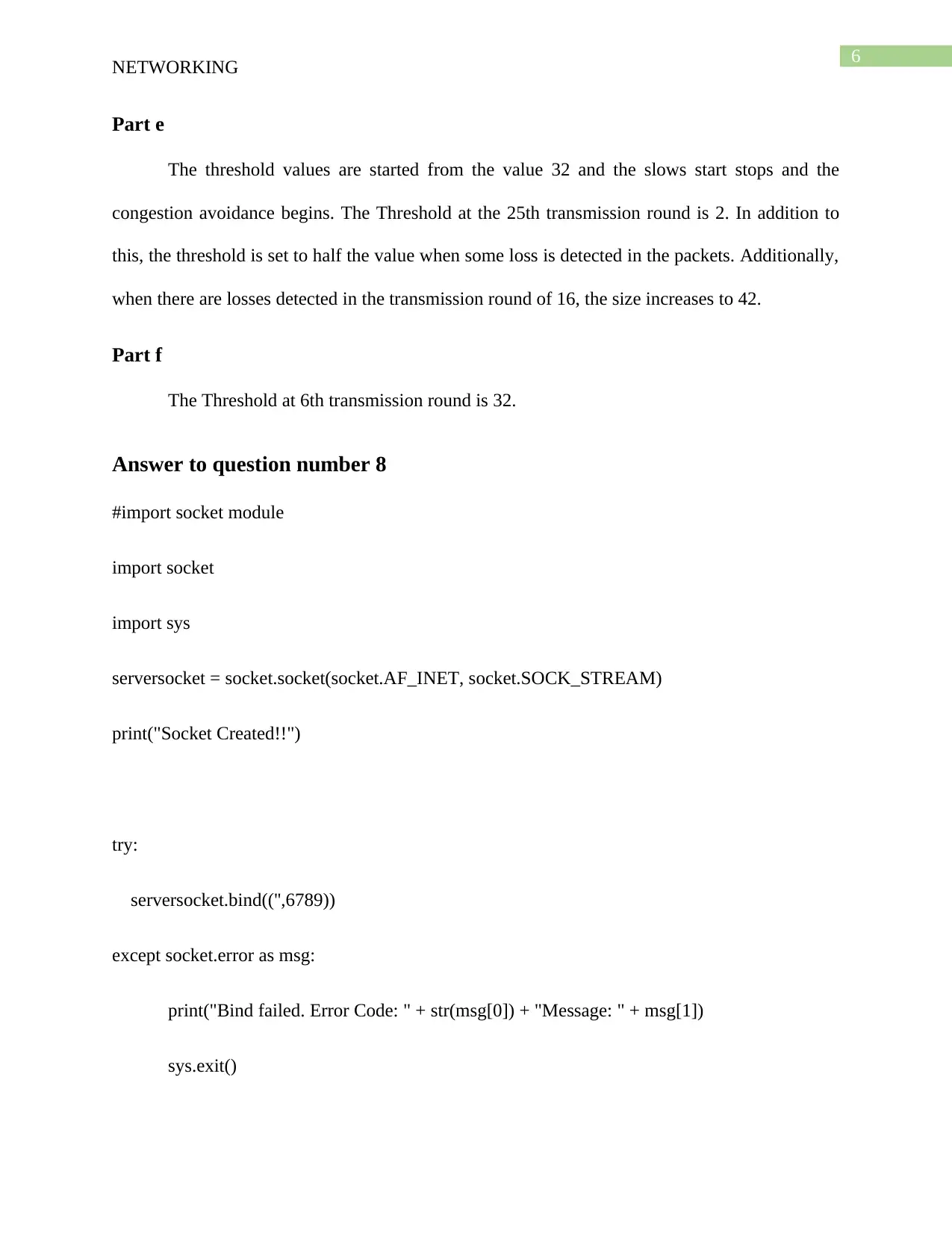
6
NETWORKING
Part e
The threshold values are started from the value 32 and the slows start stops and the
congestion avoidance begins. The Threshold at the 25th transmission round is 2. In addition to
this, the threshold is set to half the value when some loss is detected in the packets. Additionally,
when there are losses detected in the transmission round of 16, the size increases to 42.
Part f
The Threshold at 6th transmission round is 32.
Answer to question number 8
#import socket module
import socket
import sys
serversocket = socket.socket(socket.AF_INET, socket.SOCK_STREAM)
print("Socket Created!!")
try:
serversocket.bind(('',6789))
except socket.error as msg:
print("Bind failed. Error Code: " + str(msg[0]) + "Message: " + msg[1])
sys.exit()
NETWORKING
Part e
The threshold values are started from the value 32 and the slows start stops and the
congestion avoidance begins. The Threshold at the 25th transmission round is 2. In addition to
this, the threshold is set to half the value when some loss is detected in the packets. Additionally,
when there are losses detected in the transmission round of 16, the size increases to 42.
Part f
The Threshold at 6th transmission round is 32.
Answer to question number 8
#import socket module
import socket
import sys
serversocket = socket.socket(socket.AF_INET, socket.SOCK_STREAM)
print("Socket Created!!")
try:
serversocket.bind(('',6789))
except socket.error as msg:
print("Bind failed. Error Code: " + str(msg[0]) + "Message: " + msg[1])
sys.exit()
Paraphrase This Document
Need a fresh take? Get an instant paraphrase of this document with our AI Paraphraser
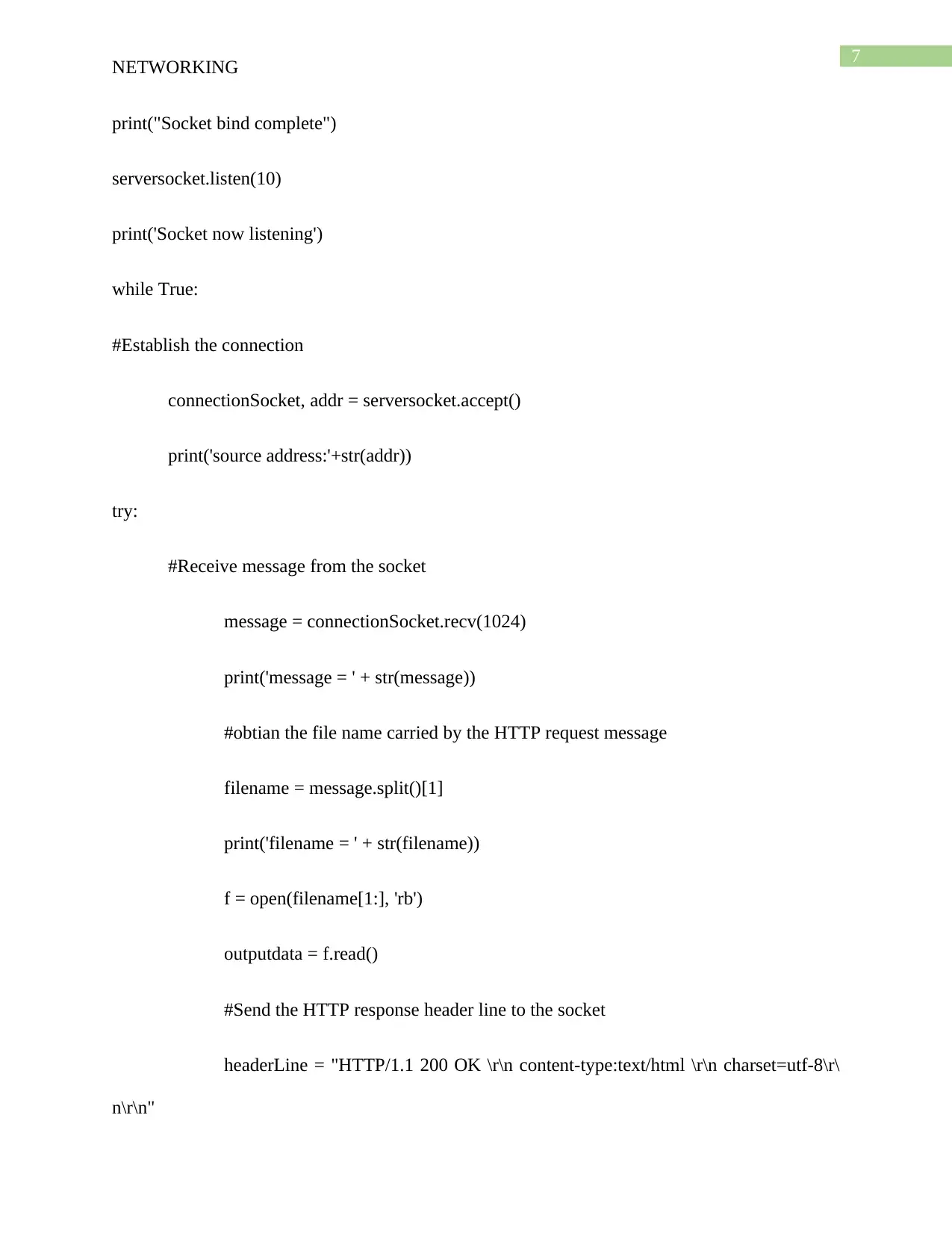
7
NETWORKING
print("Socket bind complete")
serversocket.listen(10)
print('Socket now listening')
while True:
#Establish the connection
connectionSocket, addr = serversocket.accept()
print('source address:'+str(addr))
try:
#Receive message from the socket
message = connectionSocket.recv(1024)
print('message = ' + str(message))
#obtian the file name carried by the HTTP request message
filename = message.split()[1]
print('filename = ' + str(filename))
f = open(filename[1:], 'rb')
outputdata = f.read()
#Send the HTTP response header line to the socket
headerLine = "HTTP/1.1 200 OK \r\n content-type:text/html \r\n charset=utf-8\r\
n\r\n"
NETWORKING
print("Socket bind complete")
serversocket.listen(10)
print('Socket now listening')
while True:
#Establish the connection
connectionSocket, addr = serversocket.accept()
print('source address:'+str(addr))
try:
#Receive message from the socket
message = connectionSocket.recv(1024)
print('message = ' + str(message))
#obtian the file name carried by the HTTP request message
filename = message.split()[1]
print('filename = ' + str(filename))
f = open(filename[1:], 'rb')
outputdata = f.read()
#Send the HTTP response header line to the socket
headerLine = "HTTP/1.1 200 OK \r\n content-type:text/html \r\n charset=utf-8\r\
n\r\n"
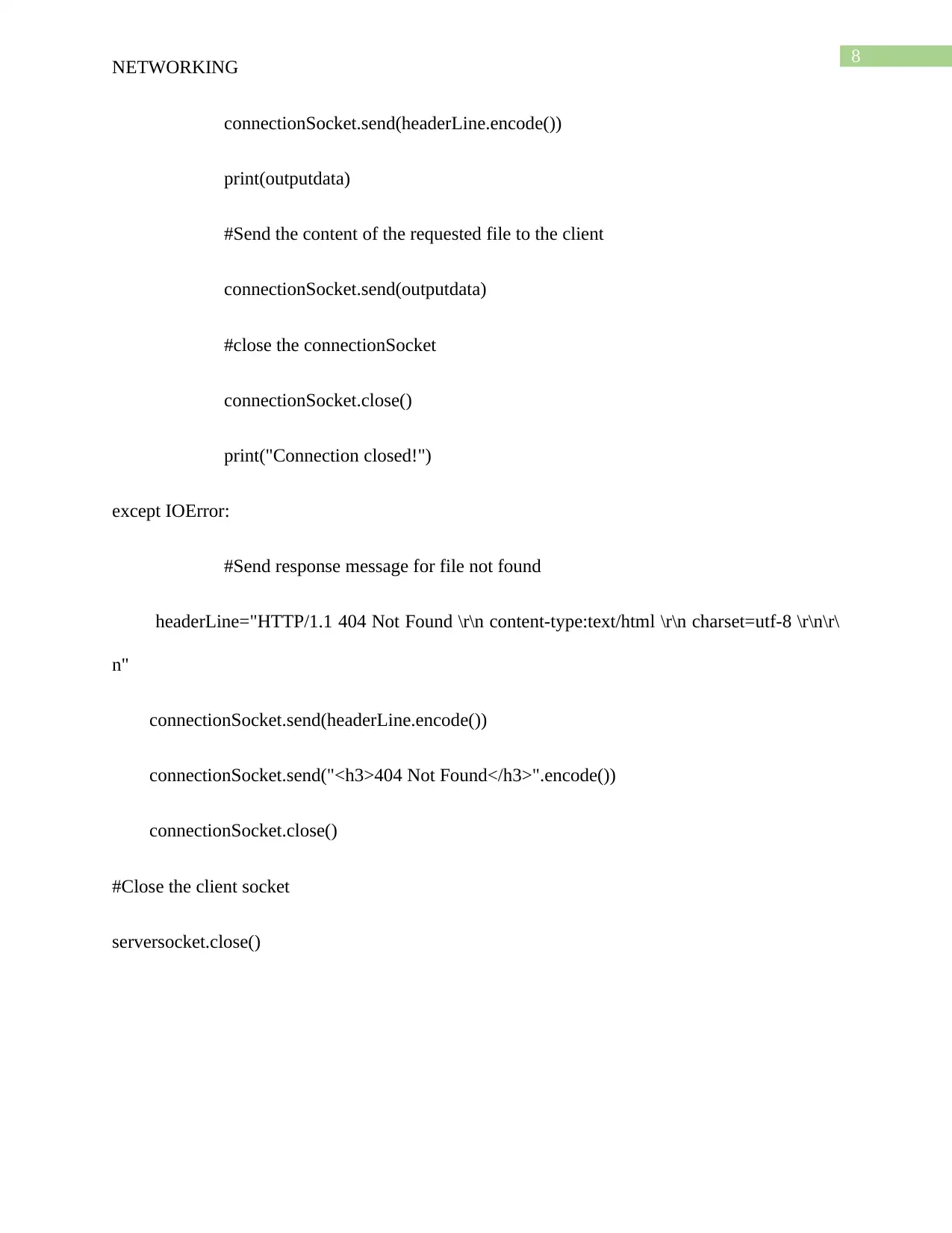
8
NETWORKING
connectionSocket.send(headerLine.encode())
print(outputdata)
#Send the content of the requested file to the client
connectionSocket.send(outputdata)
#close the connectionSocket
connectionSocket.close()
print("Connection closed!")
except IOError:
#Send response message for file not found
headerLine="HTTP/1.1 404 Not Found \r\n content-type:text/html \r\n charset=utf-8 \r\n\r\
n"
connectionSocket.send(headerLine.encode())
connectionSocket.send("<h3>404 Not Found</h3>".encode())
connectionSocket.close()
#Close the client socket
serversocket.close()
NETWORKING
connectionSocket.send(headerLine.encode())
print(outputdata)
#Send the content of the requested file to the client
connectionSocket.send(outputdata)
#close the connectionSocket
connectionSocket.close()
print("Connection closed!")
except IOError:
#Send response message for file not found
headerLine="HTTP/1.1 404 Not Found \r\n content-type:text/html \r\n charset=utf-8 \r\n\r\
n"
connectionSocket.send(headerLine.encode())
connectionSocket.send("<h3>404 Not Found</h3>".encode())
connectionSocket.close()
#Close the client socket
serversocket.close()
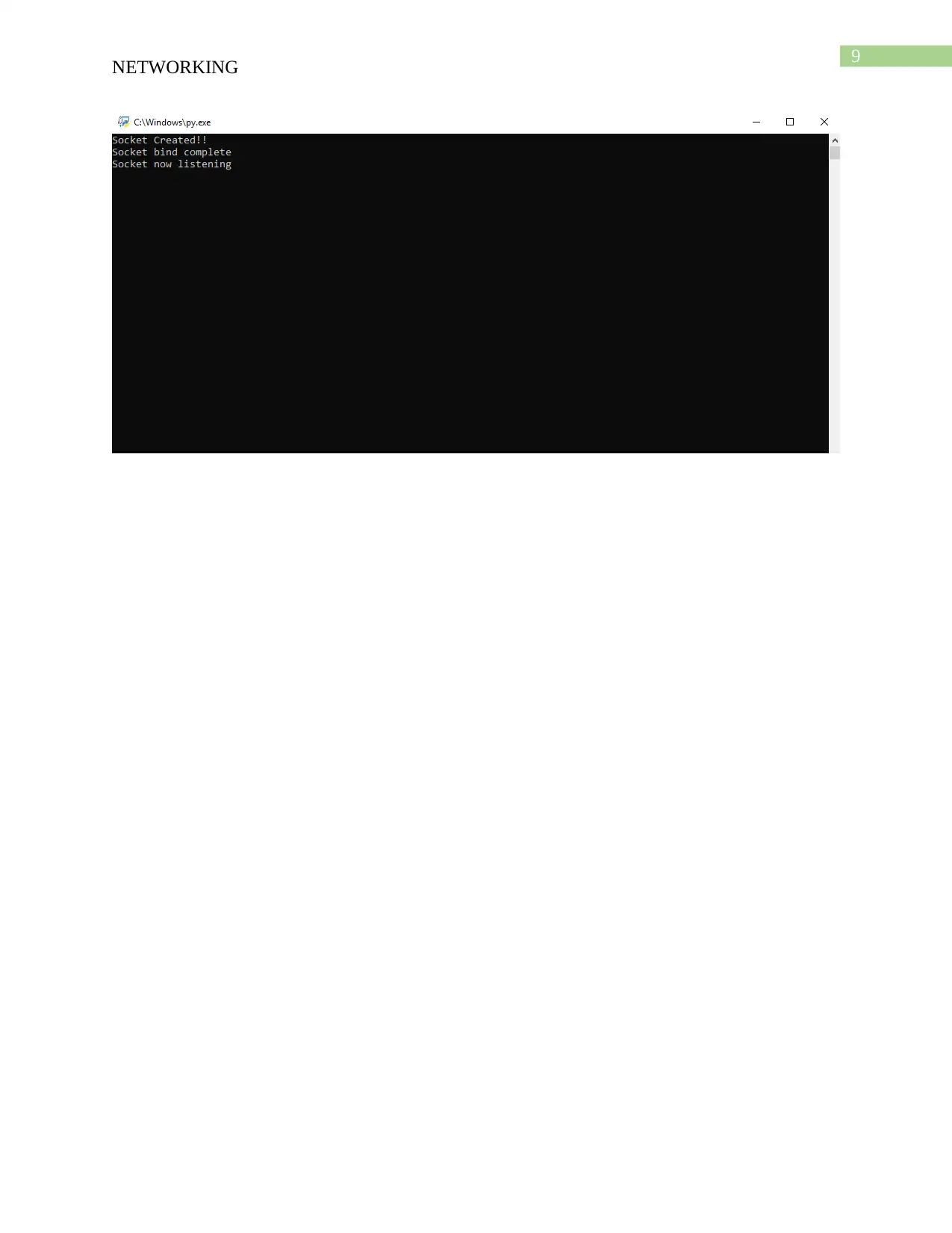
9
NETWORKING
NETWORKING
Secure Best Marks with AI Grader
Need help grading? Try our AI Grader for instant feedback on your assignments.
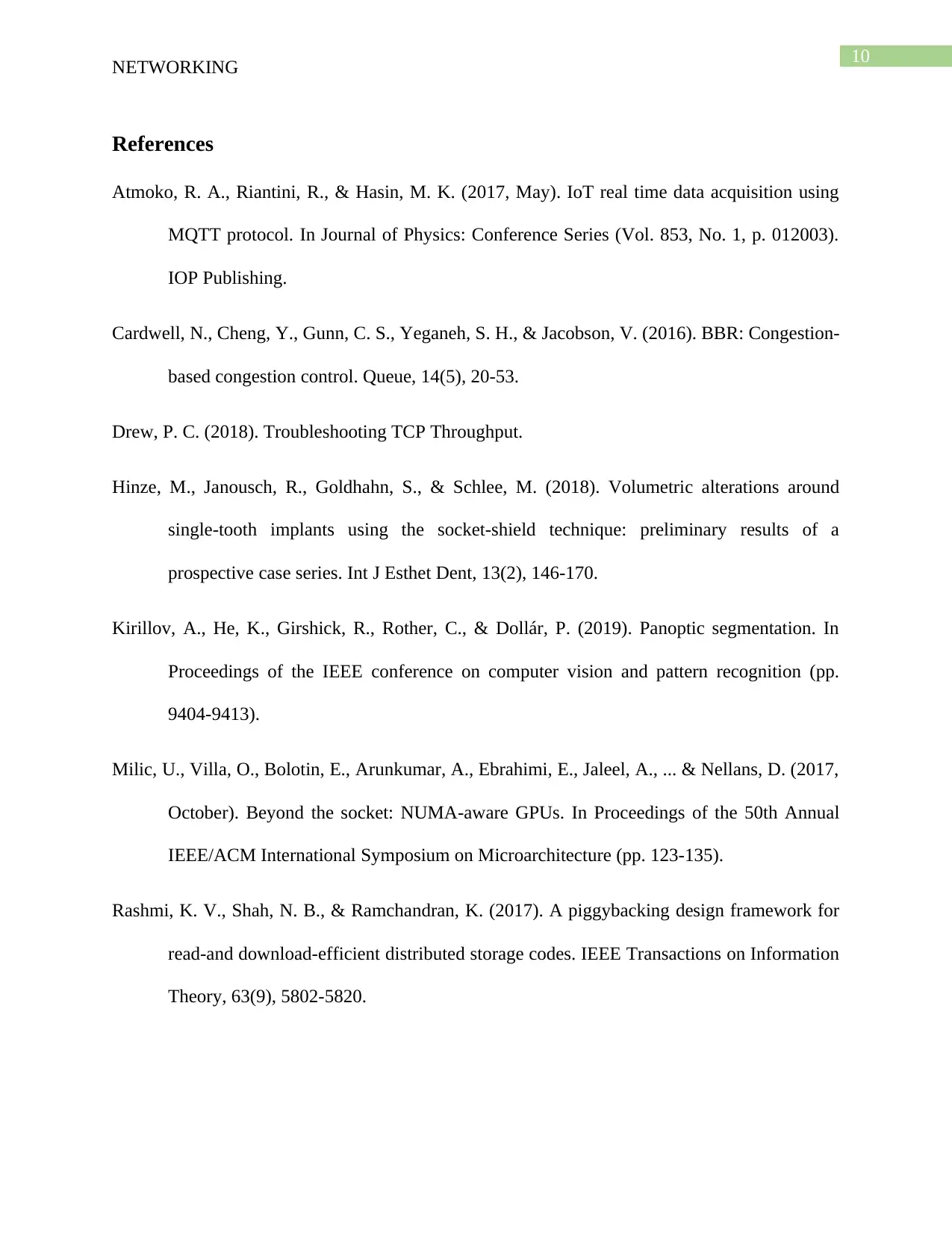
10
NETWORKING
References
Atmoko, R. A., Riantini, R., & Hasin, M. K. (2017, May). IoT real time data acquisition using
MQTT protocol. In Journal of Physics: Conference Series (Vol. 853, No. 1, p. 012003).
IOP Publishing.
Cardwell, N., Cheng, Y., Gunn, C. S., Yeganeh, S. H., & Jacobson, V. (2016). BBR: Congestion-
based congestion control. Queue, 14(5), 20-53.
Drew, P. C. (2018). Troubleshooting TCP Throughput.
Hinze, M., Janousch, R., Goldhahn, S., & Schlee, M. (2018). Volumetric alterations around
single-tooth implants using the socket-shield technique: preliminary results of a
prospective case series. Int J Esthet Dent, 13(2), 146-170.
Kirillov, A., He, K., Girshick, R., Rother, C., & Dollár, P. (2019). Panoptic segmentation. In
Proceedings of the IEEE conference on computer vision and pattern recognition (pp.
9404-9413).
Milic, U., Villa, O., Bolotin, E., Arunkumar, A., Ebrahimi, E., Jaleel, A., ... & Nellans, D. (2017,
October). Beyond the socket: NUMA-aware GPUs. In Proceedings of the 50th Annual
IEEE/ACM International Symposium on Microarchitecture (pp. 123-135).
Rashmi, K. V., Shah, N. B., & Ramchandran, K. (2017). A piggybacking design framework for
read-and download-efficient distributed storage codes. IEEE Transactions on Information
Theory, 63(9), 5802-5820.
NETWORKING
References
Atmoko, R. A., Riantini, R., & Hasin, M. K. (2017, May). IoT real time data acquisition using
MQTT protocol. In Journal of Physics: Conference Series (Vol. 853, No. 1, p. 012003).
IOP Publishing.
Cardwell, N., Cheng, Y., Gunn, C. S., Yeganeh, S. H., & Jacobson, V. (2016). BBR: Congestion-
based congestion control. Queue, 14(5), 20-53.
Drew, P. C. (2018). Troubleshooting TCP Throughput.
Hinze, M., Janousch, R., Goldhahn, S., & Schlee, M. (2018). Volumetric alterations around
single-tooth implants using the socket-shield technique: preliminary results of a
prospective case series. Int J Esthet Dent, 13(2), 146-170.
Kirillov, A., He, K., Girshick, R., Rother, C., & Dollár, P. (2019). Panoptic segmentation. In
Proceedings of the IEEE conference on computer vision and pattern recognition (pp.
9404-9413).
Milic, U., Villa, O., Bolotin, E., Arunkumar, A., Ebrahimi, E., Jaleel, A., ... & Nellans, D. (2017,
October). Beyond the socket: NUMA-aware GPUs. In Proceedings of the 50th Annual
IEEE/ACM International Symposium on Microarchitecture (pp. 123-135).
Rashmi, K. V., Shah, N. B., & Ramchandran, K. (2017). A piggybacking design framework for
read-and download-efficient distributed storage codes. IEEE Transactions on Information
Theory, 63(9), 5802-5820.
1 out of 11
Related Documents
Your All-in-One AI-Powered Toolkit for Academic Success.
+13062052269
info@desklib.com
Available 24*7 on WhatsApp / Email
![[object Object]](/_next/static/media/star-bottom.7253800d.svg)
Unlock your academic potential
© 2024 | Zucol Services PVT LTD | All rights reserved.





